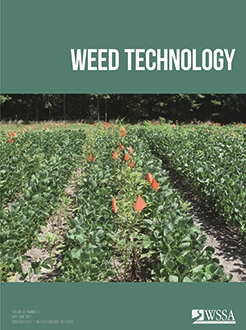As herbicide-resistant weeds become more problematic, producers will consider the use of cover crops to suppress weeds. Weed suppression from cover crops may occur especially in the label-mandated buffer areas of dicamba-resistant soybean where dicamba use is not allowed. Three cover crops terminated at three timings with three herbicide strategies were evaluated for their effect on weed suppression in dicamba-resistant soybean. Delaying termination until soybean planting or after and using cereal rye or cereal rye + crimson clover increased cover-crop biomass by at least 40% compared to terminating early or using a crimson clover–only cover crop. Densities of problematic weed species were evaluated in early summer before a blanket POST application. Plots with cereal rye had 75% less horseweed compared to crimson clover at two of four site-years. Cereal rye or the mixed cover crop terminated at or after soybean planting reduced waterhemp densities by 87% compared to early termination timings of crimson clover and the earliest termination timing of the mix at one of two site-years. Cover crops were not as effective in reducing waterhemp densities as they were in reducing horseweed densities. This difference was due to a divergence in emergence patterns; waterhemp emergence generally peaks after termination of the cover crop, whereas horseweed emergence coincides with establishment and rapid vegetative growth of cereal rye. Cover crops alone were generally not as effective as was using a high-biomass cover crop combined with an herbicide strategy that contained dicamba and residual herbicides. However, within label-mandated buffer areas where dicamba cannot be used, a cover crop containing cereal rye with delayed termination until soybean planting combined with residual herbicides could be used to improve suppression of horseweed and waterhemp.
Nomenclature: Dicamba; horseweed; Conyza canadensis L. Cronquist; waterhemp; Amaranthus tuberculatus (Moq.) Sauer; cereal rye; Secale cereal L.; crimson clover; Trifolium incarnatum L.; soybean; Glycine max (L.) Merr.






